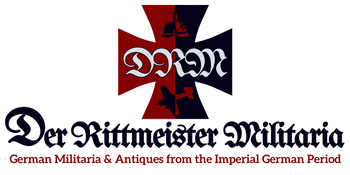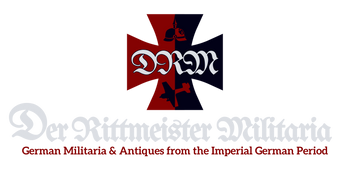Hohenzollern (Hohenzollernsche Lande)
CLICK HERE FOR ALL PRODUCTS RELATED TO HOHENZOLLERN
Basic Information
- Official Name: Province of Hohenzollern (Hohenzollernsche Lande)
- Capital: Sigmaringen
- Motto: "Nihil sine Deo" (Nothing without God)
- Established: 1850 as a Prussian province (earlier as the Principalities of Hohenzollern-Hechingen and Hohenzollern-Sigmaringen)
- Dissolution: Became part of Württemberg-Hohenzollern in 1946, later integrated into Baden-Württemberg in 1952.
-
Key Symbols:
- Coat of Arms: Features a red and white shield divided into quarters, symbolizing the Hohenzollern dynasty.
- Flag: Red, white, and black horizontal stripes, reflecting its integration with Prussia.
Geographical Overview
-
Location:
Located in southwestern Germany, bordered by Württemberg and Baden. -
Size:
The smallest territory in Imperial Germany, primarily rural, with a few towns including Sigmaringen and Hechingen. -
Land Features:
- Swabian Jura (Schwäbische Alb): A mountainous region with karst formations, caves, and dense forests.
- Danube River: Originates nearby and provides a key waterway for agriculture.
Historical Timeline
-
Early Hohenzollern:
- 11th Century: The Hohenzollern dynasty emerged as a noble family in Swabia.
- 16th–18th Centuries: Divided into the Catholic branches of Hohenzollern-Hechingen and Hohenzollern-Sigmaringen.
-
Integration into Prussia (1850):
- Both principalities ceded sovereignty to Prussia due to financial instability and internal unrest, forming the Province of Hohenzollern.
-
Imperial Germany (1871–1918):
- Remained a small administrative unit under Prussian control, contributing to German unification efforts.
-
Decline (1918):
- Continued as a Prussian province until 1946, when it was merged with Württemberg-Hohenzollern.
Notable Rulers and Leaders
- Karl Anton (1811–1885): The last Prince of Hohenzollern-Sigmaringen, who negotiated the cession to Prussia.
- Leopold of Hohenzollern: Nearly became King of Spain in 1870, sparking tensions that led to the Franco-Prussian War.
Military and Political Strength
-
Military Contributions:
- Hohenzollern provided troops to the Prussian Army, often serving in elite units.
- Known for its skilled officers who contributed to Prussia’s military successes.
-
Political Role:
- The Hohenzollern dynasty ruled Prussia and later Imperial Germany, though the province itself had limited influence.
- Played a symbolic role as the ancestral home of Germany’s imperial family.
Cultural Contributions
-
Architecture:
- Hohenzollern Castle: A medieval fortress rebuilt in the 19th century, serving as a symbol of the Hohenzollern dynasty.
- Sigmaringen Castle: A grand palace and former residence of the princes of Hohenzollern-Sigmaringen.
-
Arts and Literature:
- Supported religious art and music, particularly in Catholic churches and abbeys.
- Folk traditions, including Swabian storytelling and crafts, were preserved in rural areas.
-
Education and Science:
- Promoted Catholic education, with schools and seminaries focusing on theology and philosophy.
- Contributions to forestry and land management, reflecting the region’s rural economy.
-
Cuisine:
- Known for Swabian specialties like Spätzle (egg noodles) and Maultaschen (stuffed pasta).
- Traditional sausages and beer played a central role in local festivals.
Fall of Hohenzollern
-
World War I (1914–1918):
- The war strained the rural economy, leading to food shortages and political unrest.
-
German Revolution (1918):
- The abdication of Kaiser Wilhelm II, a member of the Hohenzollern dynasty, marked the end of Germany’s monarchy.
- Hohenzollern continued as a Prussian province until WWII.
-
Post-WWII (1946):
- Merged into Württemberg-Hohenzollern, then incorporated into Baden-Württemberg in 1952.
Connections to Products
-
Cultural Artifacts:
- Replicas and artwork featuring Hohenzollern and Sigmaringen Castles.
- Catholic religious art and artifacts tied to the region’s abbeys and churches.
-
Military Memorabilia:
- Medals, badges, and uniforms from Hohenzollern’s contributions to the Prussian Army.
- Historical maps and documents detailing the dynasty’s military influence.
-
Historical Documents:
- Royal correspondence and treaties from the Hohenzollern princes.
- Administrative records showcasing the province’s governance under Prussia.
-
Tourism and Culinary Items:
- Guidebooks and postcards featuring Hohenzollern landmarks and the Swabian Jura.
- Recipe books and tools for preparing Swabian dishes like Spätzle and Maultaschen.
-
Educational Contributions:
- Publications on Catholic theology and Swabian traditions.
- Artifacts from local seminaries and schools.







